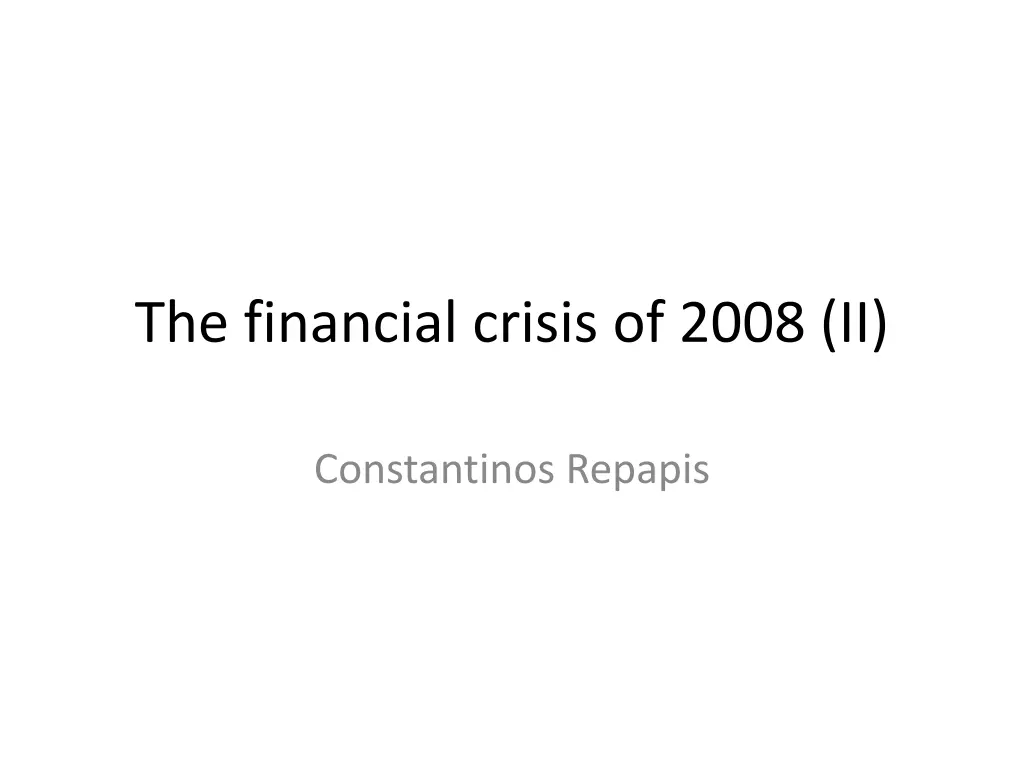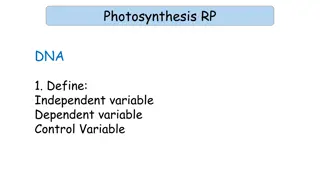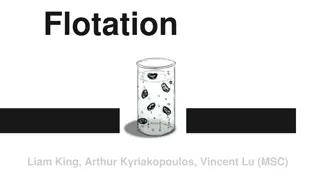
Banking Regulation Literature Post-Financial Crisis Insights
Explore the vast literature on banking regulation post-2008 financial crisis through three key perspectives: mainstream monetary policy, mainstream macro-prudential policy, and alternative post-Keynesian views on central banks. Delve into discussions on the crisis, policy frameworks, monetary policy roles, financial stability, and more.
Download Presentation

Please find below an Image/Link to download the presentation.
The content on the website is provided AS IS for your information and personal use only. It may not be sold, licensed, or shared on other websites without obtaining consent from the author. If you encounter any issues during the download, it is possible that the publisher has removed the file from their server.
You are allowed to download the files provided on this website for personal or commercial use, subject to the condition that they are used lawfully. All files are the property of their respective owners.
The content on the website is provided AS IS for your information and personal use only. It may not be sold, licensed, or shared on other websites without obtaining consent from the author.
E N D
Presentation Transcript
The financial crisis of 2008 (II) Constantinos Repapis
Literature on banking regulation The literature that has developed since the banking crisis is really vast. We will focus on three papers three perspectives - that can be found on the VLE and focus on different aspects of the crisis and modern discussions. On Mainstream Monetary Policy: Charles R. Bean & Matthias Paustian & Adrian Penalver & Tim Taylor, 2010, "Monetary policy after the fall." , Federal Reserve Bank of Kansas City, Proceedings, Economic Policy Symposium - Jackson Hole, pages 267-328. On Mainstream Macro-prudential Policy: Samuel G. Hanson, Anil K Kashyap, and Jeremy C. Stein, 2011, A Macroprudential Approach to Financial Regulation , Journal of Economic Perspectives, 25 (1). pages 3 28 An alternative post Keynesian perspective on Central Banks and their remit: Sheila Dow, 2017, Central banking in the twenty-first century , Cambridge Journal of Economics, 41 (6), Pages 1539 1557
(2010) Monetary policy after the fall The crisis was perhaps all the more remarkable because it occurred after such a long period of relatively steady growth and low and stable inflation the Great Moderation. While the causes of the Great Moderation remain open to debate, most policymakers probably put some of that improved macroeconomic performance down to better policy. Behind this view lay a consensus at least in the Anglo-Saxon world as to the ingredients making up a successful policy framework. The mainstream view of monetary policy before the crisis: Automatic stabilizers aside, fiscal policy was unsuitable as an instrument of macroeconomic demand management. Monetary policy was therefore assigned the primary role in short-term aggregate demand management, with policy conducted through the manipulation of a suitable short-run interest rate.
Pre-crisis views continued The monetary transmission mechanism operated mainly through longer-term interest rates, asset prices and expectations of future inflation. Expectations of future policy rates were central and credibility was key. The conduct of monetary policy was best delegated to an independent central bank, free of short-term political considerations. Intermediate monetary targets (like targeting money supply) were not useful because of their unstable link with the ultimate objectives of policy. Monetary policy instead focused on the only thing it could reliably determine in the long run, namely the price level. Asset markets were thought to be efficient at distributing and pricing risk, and financial innovations were normally welfare-enhancing. Even if there are bubbles there was little that monetary policy could do about them. The best monetary policy could do was to limit the fallout when sentiment turned. Systemic financial crises were seen only in history books and emerging markets; they were unlikely to happen in advanced economies with their developed and well-regulated financial markets. Price stability and financial stability were natural bedfellows, the successful achievement of one facilitating the attainment of the other.
Did this consensus create the crisis? In the normal course of events, looser monetary policy boosts asset prices directly and by boosting activity and profits, also indirectly, as these raise asset prices. But the case for monetary policy having a role in the run-up to the crisis comes less from these conventional monetary transmission channels and more from the idea that loose monetary policy particularly encouraged a shift into riskier asset classes, which then got out of hand. There are broadly three ways in which looser monetary policy encourages increased risk-taking. First, a lower yield on safe assets encourages substitution into higher-yielding risky assets, and in the process drives up their prices. Second, some investors such as pension funds need to match the returns on their investments to their commitments. A reduction in the return on safe assets encourages them to switch into high-yielding but riskier assets in an attempt to deliver nominal returns that match their liabilities. Executive compensation linked to returns also plays a role. Third, through balance sheet effects. As looser monetary policy boosts asset prices, so it encourages an expansion in banks balance sheets, putting further upward pressure on asset prices. But the number of relatively safe borrowers/projects is limited. So, the extension in the volume of loans commercial banks want to make is likely to involve moving along the risk spectrum toward more risky borrowers.
Is stability de-stabilising? The idea that periods of economic stability encourage exuberance in credit markets, thus sowing the seeds of their own destruction, is a key part of Minsky s theory of recurring financial crises. The results in this paper provide some empirical evidence for such a dynamic process. Also, to the extent that better policy accounted for the Great Moderation, it provides a second, indirect, channel whereby policy may have contributed to creating the conditions conducive to a subsequent financial bust. However, the understanding of this (2010) paper of Minsky s insight is superficial. It simply assumes there is a simple and easy separation between stability and instability and good and bad monetary policy. Therefore the authors write: But it would clearly be a mistake to conclude that policy should aim to induce fluctuations in the macroeconomy in order to prevent financial market participants becoming too confident about the outlook! The right moral is surely that policymakers need to be most vocal about the risks to the outlook when things appear to be going well, and to take appropriate restraining action if needed. We will return to this problem in the next two papers.
The new mainstream consensus What has changed since the crisis? Revisiting some key issues: The role of fiscal policy. The effectiveness of expansionary fiscal policies in stimulating demand remains a matter of debate. It also raises the problem of debt sustainability. The role of monetary policy. Monetary policy is still preferred to fiscal policy for short-term aggregate demand management (outside a crisis). The monetary transmission mechanism. The crisis has brutally ex- posed the limitations of conventional macroeconomic analysis ignoring the role of financial intermediaries. The crisis has illustrated the need to take seriously the problem of incentives facing the intermediaries. Central bank independence. Nothing suggests that the thinking behind the delegation of monetary policy to an operationally independent central bank is flawed.
The pursuit of price stability. Because monetary policy failed to prevent the crisis, some have suggested that the emphasis on inflation targeting has failed. The maintenance of price stability may be insufficient on its own to guarantee continued over-all macroeconomic stability, but it surely has to remain the central objective of monetary policy in the long run, even if other considerations may intrude in the short run. Any other objective risks de-anchoring price expectations and inducing unnecessary extra volatility into the economy. Monetary policy and credit/asset-price booms. The twin beliefs that financial markets are efficient and that financial innovation is necessarily welfare-enhancing have been dealt a serious blow by the crisis. Financial markets are riddled with incentive distortions and market failures. Monetary policy does not seem like the most appropriate instrument to deal with this. The deployment of macro-prudential instruments, focused more directly on the source of the excessive exuberance, seems more appropriate. The relationship between price stability and financial stability. Price stability is not a sufficient condition for financial stability. In fact the reduction in volatility associated with price stability may have contributed to excessively optimistic assessments of risk, the compression of risk premia and the expansion in leverage. That does not imply central banks should retreat from the pursuit of price stability and macroeconomic stability more generally. But it does suggest that policymakers need both to be aware that long periods of benign conditions may foster excessive private- sector risk-taking.
(2011) A Macroprudential Approach to Financial Regulation Going forward, a critical question for regulators and supervisors is what their appropriate field of vision should be. Under our current system of safety-and-soundness regulation, supervisors often focus on the financial conditions of individual institutions in isolation. An alternative approach, which has been called system-wide or macroprudential oversight, would broaden the mandate of regulators and supervisors to encompass consideration of potential systemic risks and weaknesses as well. (Federal Reserve Chairman Ben Bernanke, 2008) A microprudential approach is one in which regulation is partial equilibrium in its conception and aimed at preventing the costly failure individual financial institutions. A macroprudential approach recognizes the importance of general equilibrium effects, and seeks to safeguard the financial system as a whole.
The Moral Hazard Problem Moral Hazard definition: Someone increases their exposure to risk when insured. Therefore, a person takes more risks because someone else bears the cost of those risks. Moral hazard arises when the taking of insurance changes the behavioural response to risk taking. Usual reasons the problem arises is an information asymmetry. One part of the transaction has information not available to the other and exploits this knowledge difference. The basic argument in this setting is: Bankers are rational and self-interested and they do not care of the social costs of their actions. Bankers know that the government will intervene when there is a crisis to save the banks for the benefit of the economy. This means that they can always rely on the government to bail them out if things go wrong. Their actions are fully insured. This motivates them to take more risky decisions than they would otherwise take. If they make profits because of higher risk, they will make high bonuses. Otherwise they will simply be bailed out and the government pay their losses. This leads to too much risk taken by the banks, and eventually to a crisis, as these risky investment turn bad. Policy conclusion: Do not bail out banks that fail or you will create a Moral Hazard problem.
Microprudential regulation Traditional microprudential regulation of banks is based on the following logic: Banks finance themselves with government-insured deposits. While deposit insurance has the valuable effect of preventing runs it creates an incentive for bank managers to take excessive risks knowing that they will be bailed out. The goal of capital regulation is to force banks to internalize losses, thereby protecting the deposit insurance fund and mitigating moral hazard. If the probability of the deposit insurer bearing losses is reduced to a low enough level, microprudential regulation is doing its job. The basic critique of microprudential regulation can be understood as follows: When a regulator pushes a troubled bank to restore its capital ratio, the regulator does not care whether the bank adjusts via raising new capital or by shrinking assets. Either way, the bank s probability of failure is brought back to a tolerable level, which is all that a microprudential regulator cares about.
Macroprudential policy In the simplest terms, one can characterize the macroprudential approach to financial regulation as an effort to control the social costs associated with excessive balance sheet shrinkage on the part of multiple financial institutions hit with a common shock. For macroprudential regulation, two questions must be answered. First, what are the costs imposed on society when many financial firms shrink their assets at the same time? Second, why do individual firms not internalize these costs? That is, why do they not raise fresh capital rather than reduce assets when a bad shock hits? Or alternatively, why do they not build sufficiently large capital buffers ahead of time so that they can withstand a shock without needing either to raise capital or to reduce assets?
The Fire sales problem Fire sales definition: Is the sale of goods at extremely discounted prices. Fire sales occur in the financial markets when bidders who value assets highly are prevented from bidding on them (because of liquidity or other constraints), depressing the average selling price below what it otherwise would be. This lowering of the price can cause even further issues, and price drops, because it may be inaccurately perceived as signalling negative information. The transition mechanism: A bank wants to reduce its exposure to riskly assets as economic forecasts turn negative. The bank can clean its balance sheet by dumping illiquid securities (think of toxic mortgage-backed securities) into the market. Prices for these securities drops sharply. Bank A s sale decision does not take account for the fact that it degrades the collateral value of any assets it or other banks hold. A s fire-selling of its assets lowers the liquidation value that Bank B can realize for these same assets. Even if, at some point, the good in fire sale is priced reasonably, there are no buyers because of collateral constraint. Banks ability to raise cash to buy assets is constrained by the collateral value of their own assets which is decreasing. This creates a downward spiral, good banks which did not take a lot of risk go down with bad banks, that started the fire sale.
Policy conclusions of this literature Essentially macroprudential policy is a balancing act between incentives problems and systemic risks. Policy conclusions/suggestions are varied and include: Regulate bank manager s bonuses. E.g. have them take bonuses on average profits of a few years rather than one year to mitigate the incentives problem. Increase capital requirements for banks (or/and improve the quality of capital that banks hold), so that they are more solvent if a crisis hits. Regulate more the shadow banking sector, and create barriers between commercial/investment and other banking institutions. Thus if a crisis hits in one highly speculative fringe market, it does not influence the rest of the economy. In general the policy conclusion of this literature is to find the right institutional market framework that would align individual incentives with socially optimal outcomes.
Problems remain While higher capital and liquidity requirements on banks will no doubt help to insulate banks from the consequences of large shocks, the danger is that, given the intensity of competition in financial services, they will also drive a larger share of intermediation into the shadow banking realm If so, the individual regulated banks may be safer than they were before, but the overall system of credit creation may not.
(2017) Central banking in the twenty- first century Sheila Dow (2017) a prominent heterodox economist outlines several key issues on central bank operations and remit post-crisis. She notes that the mainstream view still has a technocratic approach to central banking theory. She argues in favour of a more traditional political economy approach. It is argued that central banking needs a new framework which recognises the interdependencies between the conditions for monetary stability, financial stability and economic stability and between the policy measures by which these goals may be addressed.
The Bank of Englands describes the Banks mission as to promote the good of the people of the United Kingdom by maintaining monetary and financial stability. How is monetary stability and financial stability understood? How are they to promote the good of the people? Who decides on trade-offs? The mainstream practice of conceptual separation in e.g.: monetary variables from real variables economic analysis from non-economic argument monetary stability from financial stability implies a particular system of values and methodology in understanding the economy. Instead Dow argues in favour of a non-mainstream ontology of complex interconnectedness. This is because an evolving social system requires conceptual interconnectedness for its analysis. Implications are drawn for the need for a new framework for central banking which recognises the interdependencies between the different goals for central bank policy and the methods of achieving them.
The Post Keynesian approach, continues to develop central banking theory within the political economy tradition. Interdependencies are emphasised, as highlighted by Radcliffe: it is no longer appropriate to charge the monetary authorities with unambiguous tasks that can be sharply differentiated from other government action . Monetary and financial stability are seen as interdependent with each other and with economic stability. Post Keynesians also argue that financial instability is a more basic problem than monetary instability (e.g. inflation). They argue that financial instability exacerbates real economic instability and thus monetary instability. This implies that economic and financial stability are the more appropriate primary goals of central bank policy from which monetary stability would follow.
Monetary and fiscal policy are interdependent through the bond market. But the current framework for central banking does not address these interdependencies, seeing the bond market either from an open market operations perspective or a government deficit one. This constrains the scope for central bank policy and leads to contradictory and self defeating actions. If policy is for the good of the people , then Central Bank policy should include concerns on: The distribution of income and wealth, following from its policies. The trust in institutions which support money as a social relation. Other social objectives decided by the elected government. Importantly, it cannot claim its mandate is on a narrow technocratic remit- to achieve a level of inflation- and that therefore its actions are politically neutral.
Alternative understanding Why not use monetary and fiscal targets in collaboration? For example use QE to achieve also an environmental or social target. Therefore QE would be a mechanism for injecting new liquidity into the economy in a way which supported government policy. The basis of sound money in society is trust, and this should be the main objective of our economy. While some bank failures might occur in isolated instances, requiring careful management, these should be exceptional. Closing banks as a moral hazard deterrent is a catastrophic policy. Moral hazard is not an inherent problem of individual behaviour in a state of nature, but exists because the system stresses a particular kind of behaviour. Therefore what is needed is not a new set of incentives, but a change in the banking and societal culture and values. Bank culture is highly complex, embedded in particular environments, so restoring an appropriate culture is not an easy matter. But efforts can be made in that direction within the monitoring and supervision functions; this is not done at present.
Why should only the market prices system determine who has access to credit? Changing the structure of banking motivated by the need for credit in order to serve the government s socio-economic goals. Market-driven credit allocation is inefficient with respect to economic performance, given that it is governed by the distorted knowledge base (given uncertainty) and incentive problems (given the current culture). Both government planned and private-government collaborations could develop to allocate credit for different reasons and through other processes. What about central bank independence? The interconnectedness of monetary policy and financial stability with fiscal policy and other government goals, e.g. with respect to social inclusion or sustainable development, can no longer be ignored. Post-Keynesians focus on interconnectedness. Thus: An inflation target is no longer, an absolute priority, and not separable to financial stability. There are many possible (institutional and procedural) forms of central bank independence, including a central bank mandate which set out areas for cooperation with government, a joint-committee structure to manage that cooperation and an appropriate set of incentives for central bankers, etc.
Sheila Dow- Conclusions Return to the principle that the Central Banking should ensure that there is trust in the monetary system as its main objective. This can include new policies, not now within the public discussion. Like the generation of credit to finance real economic activity in such a way as to support government policies with respect to its socio-economic goals (such as reducing income inequality and conserving natural resources). New perspectives on banking regulation. Central bank guarantees for retail bank deposits is crucial, as a quid-pro-quo for regulation to ensure a prudent bank asset structure. Financial innovation inevitably requires central banks to be sensitive to the evolution of retail banking. It also requires central banks to oversee the asset structures of an ever-widening range of types of institution developing new products and practices. The pretence of independence between fiscal and monetary policy needs to be dropped and a more sensible mechanism restored for monetary financing of deficits when required. Too much responsibility has been placed on central banks for macroeconomic policy when in fact fiscal policy is the more appropriate way of dealing with recession.






















